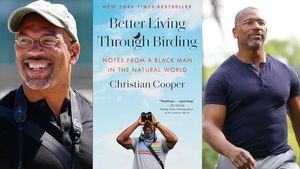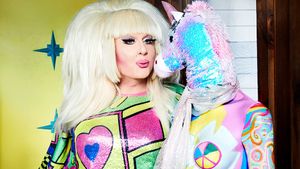Even before joining Queer Eye in 2018, Bobby Berk had made a name for himself as an expert designer. Now, for season 7 of the hit Netflix series, he brings his talents to the historic city of New Orleans, performing life-changing home renovations for a new set of heroes. Off-screen, he’s been thinking about the intersection of interior design and mental health. It’s the subject of his debut book, Right at Home: How Good Design Is Good for the Mind, coming this September.
Ahead, Berk talks Queer Eye season 7 — out now on Netflix — how our surroundings impact every aspect of our lives, and why you should fill your home with things you love.

Out: How did working in New Orleans for Queer Eye season 7 influence your design process?
Bobby Berk: The great thing about New Orleans is it’s almost like you’re filming in a foreign country. New Orleans is a completely unique city compared to anywhere else in the U.S., and really anywhere else in the world. It’s such a clash of so many different cultures that you don’t find anywhere else. And I think that one thing that you can take from doing design in New Orleans is to embrace the history and to embrace the old. To love the old. So many times, designers want to come in and start from scratch and gut everything. But the beauty is in the old details in New Orleans, and a lot of the time it’s worth saving.
What was the renovation process like for Stephanie, one of season 7’s heroes?
I always love when I get a blank slate, because when I don’t have to spend an entire day of my three-day schedule to clean out a house, it allows me to be a lot more creative. So the process was really fun with Steph because I got to go into a completely empty house and do whatever I wanted, and a house that was already quite nice. It really just needed me to come in and put beautiful things in it instead of trying to change the space.
Does a blank space pose any challenges?
No. For me, I like it when I get to do exactly what I want. And when there’s too much reference, sometimes it makes it a bit cloudy — like when I walk into a space and there’s so much going on that you can’t really see the person, right? Like, wait, is this pile of stuff them? Or is this pile of stuff them? Or is this pile of stuff them? With Stephanie, there wasn’t that.
What did you take into account about Stephanie when designing her home?
I knew that she was a huge [New Orleans] Saints fan, so that was my way to infuse her personality in there. And then I talked a bit to [Stephanie’s partner] Ray, and she was like, “You know what? I just like clean and serene." So I went with a lot of neutrals, a lot of clean lines. But one of the things about their home — living with her father previously to this — was that there were no pictures of them together in the house. They kind of erased themselves as a couple to make their family feel more comfortable when they came over, and so I just filled their house full of pictures of them. And it was cute. It was one of the first things Ray noticed when she walked in. She was like, “There’s pictures of us. It feels like our home.”
 BEFORE: Stephanie’s living room prior to Bobby Berk’s 'Queer Eye' transformation
BEFORE: Stephanie’s living room prior to Bobby Berk’s 'Queer Eye' transformation
 AFTER: Stephanie’s living room following Bobby Berk’s 'Queer Eye' transformation
AFTER: Stephanie’s living room following Bobby Berk’s 'Queer Eye' transformation
When you’re starting any renovation process, what are some of the first steps you take?
A lot of times people aren’t able to articulate what their design style is. And as a designer, it’s my job to figure [that] out for them, even if they have no idea. I learned very quickly in the first episode with Tom [Jackson] — rest in peace — to not ask, “What’s your design aesthetic?” What I learned is to ask them about things that are completely unrelated to design.
Can you share an example?
If you go back to the episode of Remi, which was season 2, he had his grandmother’s home that he had inherited. It was very cool in the ’70s, but it was not very cool for a 20-something-year-old bachelor. So I asked him, “What’s your favorite television show?” And he was like Mad Men. And I’m like, “Where’s your dream vacation?” And he’s like Cuba. Mad Men’s in the ’50s, Cuba’s stuck in the ’50s, so clearly he’s gotta love mid-century. So I put mid-century furniture in his home, and I did this really cool mural of Cuba, and did palm leaf and banana leaf wallpaper in the kitchen nook. And he walks in and he’s like, “My God, this is so me. You knew more about me and what I like to design before I even realized it. How?” And I just asked him about the things he loves. So don’t let design be so scary. If you fill your house with things that you love, it’s gonna be perfect for you.
After seven seasons of Queer Eye, how have you changed as a designer?
I’ve gone from — before the show — doing homes over the span of a year, to doing them in a week. And now in New Orleans, I’m doing them in about three days. Normally we have a week per episode, but this season our shooting schedule was shortened to about three days per episode, so I was doing two to three houses at the same time. I’ve gotten better with time management. My team has gotten better with time management. I have an amazing team that I would not be able to do any of this without.
How have you changed as a person?
I think one of the things I’m most proud about is that I haven’t changed much from season 1 to season 7. I really go out of my way to try to be my most authentic self at all times and that includes not letting, you know, fame change me. I always try to be the same person I was and to stay as grounded as possible. And I do that by surrounding myself with the same friends that I have had for decades and keeping the same husband around that I’ve had for decades.
How does it feel being a gay public figure in this troubling political climate?
I feel honored to be able to be visible. In a time where a lot of communities are losing hope, I try to be that beacon of hope and let people know that, yes, it may be bad in some places, but you can still go out there and live your best life, you can find your tribe, and you can find your chosen family. The bad people are always the loudest, and a lot of times you start to feel like, God, this is all that’s out there. But we go into these areas that you would expect to hear nothing but bad, bigoted, hateful people, and what Queer Eye shows you is, no, that’s not everyone — that’s a select group of really loud assholes who try to make it look like they’re speaking for everybody, but they’re not. You can still find amazing, loving, wonderful people in these small towns in the South who love and accept you for exactly who you are. So I feel honored to be on a show that not only allows me to be proud and visible, but also shows the good side of everyone and everywhere.
 Stephanie’s bedroom following Bobby Berk’s Queer Eye transformation
Stephanie’s bedroom following Bobby Berk’s Queer Eye transformation
You have a book coming September 12, Right at Home: How Good Design Is Good for the Mind. What led you to distill your design philosophy into a book?
Ever since the show’s come out, people are like, do a book, do a memoir, do a design book. I didn’t really wanna do a memoir — I feel like I’ve got a lot of living to do before I do that. And I didn’t wanna just do a pretty design book. Those are great, they all have their place, but anything I do in life, I want it to help people. So I’ve been thinking about the intersection of mental health and design for quite a few years now, and finally, I put my ideas on paper and went out and got the book sold.
How is good design good for the mind?
The space that you surround yourself with really does have a major effect on the rest of your life. Your home is kind of like your phone’s charger, and if you don’t plug your phone in at night to that charger — if that charger has a short in it — your phone’s not gonna get fully charged and [it’s] gonna die the next day. Your home is your charger, and when you go home at night, you need to fully recharge.
What tips can you share?
[Your home] needs to be a place of serenity and relaxation, surrounded by things that, as Marie Kondo would say, spark joy and bring you happiness. It goes back to some of the things I talked about earlier: asking yourself about the things you love, not about design stuff. It goes into the way colors make you feel, lighting, organization.
What are some ways our surroundings impact our mental health?
Chaos around you creates chaos in your mind. When I walk into people’s homes, especially on Queer Eye, I can look and see the tell-tale signs of depression. There are piles of laundry that have clearly been there a long time. I pull these things from my own life too. I can tell when I start to get a little depressed, things like that kind of fall by the wayside, and they start to pile up. You wake up in the morning, you see that pile of laundry, and your first feeling is one of failure. People don’t think about the fact that those little moments start to add up in your mind, and they give you either a sense of accomplishment or a sense of failure. And it’s literally just the simplest thing of making your bed the first thing when you get up in the morning that gives you a sense of accomplishment instantly. But if you started out with a sense of failure, it’s a snowball effect with that too. It’s things like that throughout the book that help you realize just how much your surroundings and home can affect every aspect of your life.
This article is part of the Out May/June issue, available on newsstands May 30. Support queer media and subscribe -- or download the issue through Amazon, Kindle, Nook, or Apple News.





 BEFORE: Stephanie’s living room prior to Bobby Berk’s 'Queer Eye' transformation
BEFORE: Stephanie’s living room prior to Bobby Berk’s 'Queer Eye' transformation  AFTER: Stephanie’s living room following Bobby Berk’s 'Queer Eye' transformation
AFTER: Stephanie’s living room following Bobby Berk’s 'Queer Eye' transformation  Stephanie’s bedroom following Bobby Berk’s Queer Eye transformation
Stephanie’s bedroom following Bobby Berk’s Queer Eye transformation 

































































